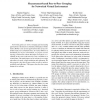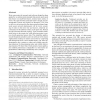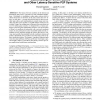299 search results - page 45 / 60 » Server-Side Design Principles for Scalable Internet Systems |
ESCIENCE
2006
IEEE
15 years 4 months ago
2006
IEEE
We have designed a maximum likelihood fitter using the actor model to distribute the computation over a heterogeneous network. The prototype implementation uses the SALSA program...
ICDCSW
2005
IEEE
15 years 3 months ago
2005
IEEE
Networked games are newly emerging and increasing applications in the Internet community. Multiplayer Online Game (MOG) is one of such applications that can accommodate many users...
SENSYS
2006
ACM
15 years 4 months ago
2006
ACM
Most sensor network research and software design has been guided by an architectural principle that permits multi-node data fusion on small-form-factor, resource-poor nodes, or mo...
68
Voted
SAC
1998
ACM
15 years 2 months ago
1998
ACM
This paper describes a hypermedia infrastructure, called HyperDisco, designed to address important issues such as integration, collaboration, versioning, scalability, openness, di...
SIGCOMM
2009
ACM
15 years 4 months ago
2009
ACM
– The latency between machines on the Internet can dramatically affect users’ experience for many distributed applications. Particularly, in multiplayer online games, players s...



